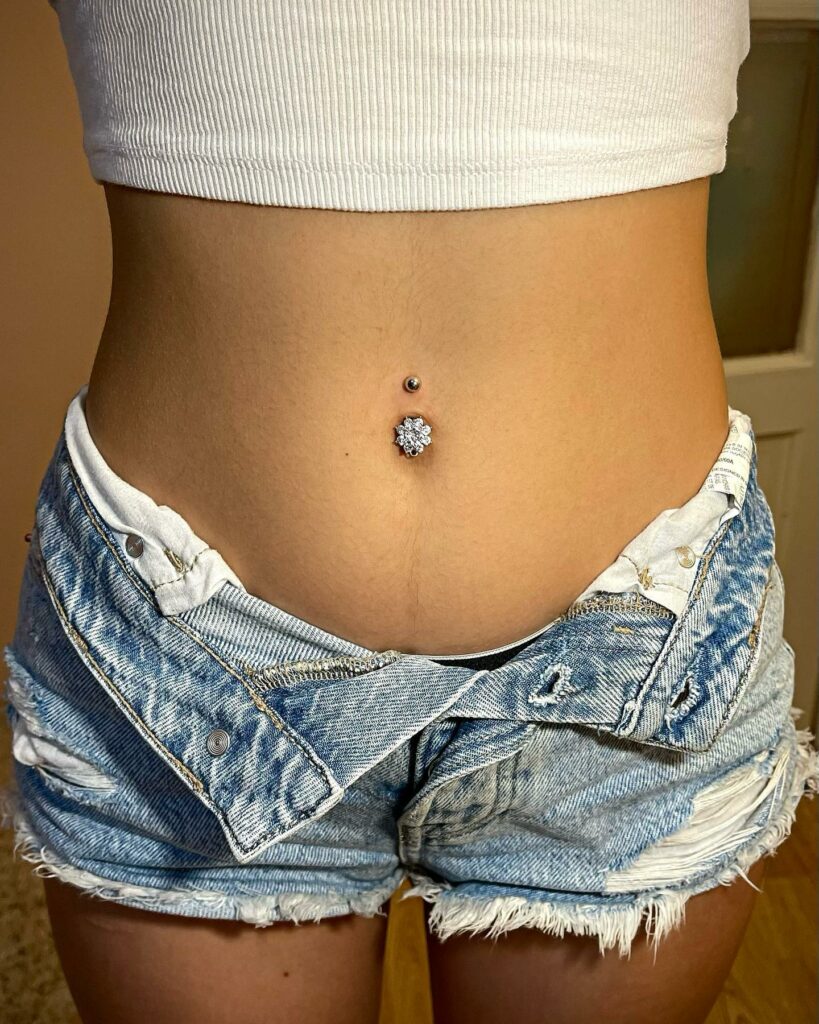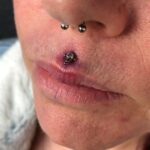Table of Contents
Whether you’re a piercing pro, a beginner who is just exploring, or someone in-between, you’re about to get an insider’s look at the belly button battleground, and come out the other side more informed and prepared to enjoy the thrill of the piercing journey.

What Is Belly Button Piercing Rejection?
In medical terms, piercing rejection happens when your body’s immune system identifies the jewelry in your piercing as a foreign object and tries to get rid of it. It’s a protective mechanism, really. Your body’s trying to protect you just as it would if you had a splinter or a shard of glass lodged in your skin.
So, what does it do? Well, your body slowly starts to push the jewelry towards the surface of the skin, in an attempt to eject it. That’s why you may notice that your piercing appears to ‘move’ or seems shallower over time.
It’s pretty fascinating when you think about it – your body’s doing what it’s designed to do, protect you. However, it can be disappointing when it’s rejecting something you really want, like a belly button piercing. I hope this explanation clarifies the concept for you!

What Causes A Rejected Belly Button Piercing?
There are various reasons why your navel piercing might face rejection. One key reason is that you might have chosen unsuitable jewelry for it, perhaps the wrong size or an incompatible metal.
If you’ve previously experienced metal sensitivities with other piercings, it’s a good idea to avoid those materials. Instead, opt for metals that are less likely to be rejected. While stainless steel is a common and affordable choice, it’s often more prone to rejection compared to others like titanium, especially if you have sensitive skin.
As for the size and weight of your jewelry, you want to be in the Goldilocks zone – not too small or big, too light or heavy. An experienced piercer can guide you to find what’s just right.
The location of your piercing also matters. If the piercing is closer to the surface of your skin, it’s more likely to be rejected. Aim to have a bit more skin between the piercing and the surface.

Common Signs & Symptoms Of A Rejected Belly Button Piercing
Being vigilant can help you identify piercing rejection early. Here’s what to watch out for:
1. Migration: This is when your belly button jewelry starts moving closer to the skin’s surface. Some migration is normal, but if it’s consistent, it could indicate rejection.
2. Increased Soreness: Some soreness after piercing is expected, but if it worsens without signs of infection, it could signal rejection.
3. Visible Jewelry Bar: If the bar of your belly button jewelry becomes visible through your skin, it suggests migration is happening and rejection might be underway.
4. Looser Jewelry: When rejection starts, the jewelry doesn’t fit as snugly as before.
5. Enlarged Piercing Holes: If the holes at the piercing sites seem to be enlarging, keep an eye out for other signs of rejection.
6. Increased Discharge: Some discharge is normal post-piercing, but if it slows down and then resumes, it might mean rejection.
7. Formation of Keloids or Scars: If a scar or keloid forms around your piercing, it might point to rejection.

Can You Salvage a Rejected Belly Button Piercing?
If you catch the signs of rejection early enough, there’s a chance to save the piercing. However, if the jewelry is visibly protruding through the skin, it’s best to let the area heal and consider re-piercing later. Remember to keep the piercing clean to prevent complications.
Preventing Belly Button Piercing Rejections
To avoid rejection, start with a metal that’s easy for your body to tolerate. Avoid nickel, a common allergen. Titanium and niobium are good starting points. Ensure that the jewelry size and weight are suitable, which is where an experienced piercer’s guidance comes in handy.
Can You Re-pierce After a Navel Piercing Rejection?
The good news is, you can have your belly button re-pierced after healing. While there are no guarantees, many people have found a compatible metal after an initial rejection. Consult with your piercer about metal choices that can decrease the chance of another rejection.

Conclusion
Just remember, your body is unique and a veritable canvas for self-expression, so it’s crucial to consult with an experienced piercer who can guide you on placement and jewelry choice, all while respecting your body’s natural boundaries.
Generally, the cost of a navel piercing can vary anywhere from $30 to $70, depending on your location and the expertise of the piercer. Remember, choosing a professional isn’t the time to bargain hunt – experience and knowledge are worth every penny.
As for the potential downsides, they’re usually minimal if you take proper care. The biggest risk is rejection, which we’ve delved into thoroughly. There’s also the possibility of infection, but regular cleaning and post-piercing care should keep that risk at bay.
Ultimately, it’s about striking a balance – the balance of expressing yourself with the bling you love, while still listening to your body’s cues. After all, it’s a two-way street, and your belly button deserves nothing but respect and care on its journey to becoming the sparkling centerpiece of your self-expression. Dance on, my friends.




